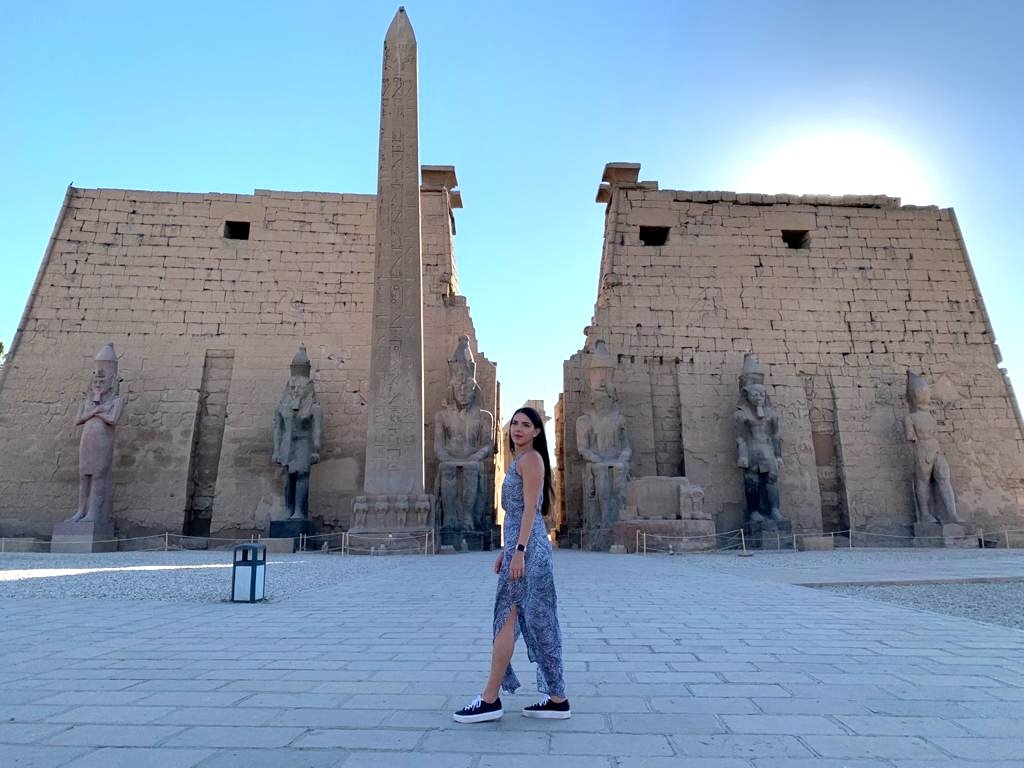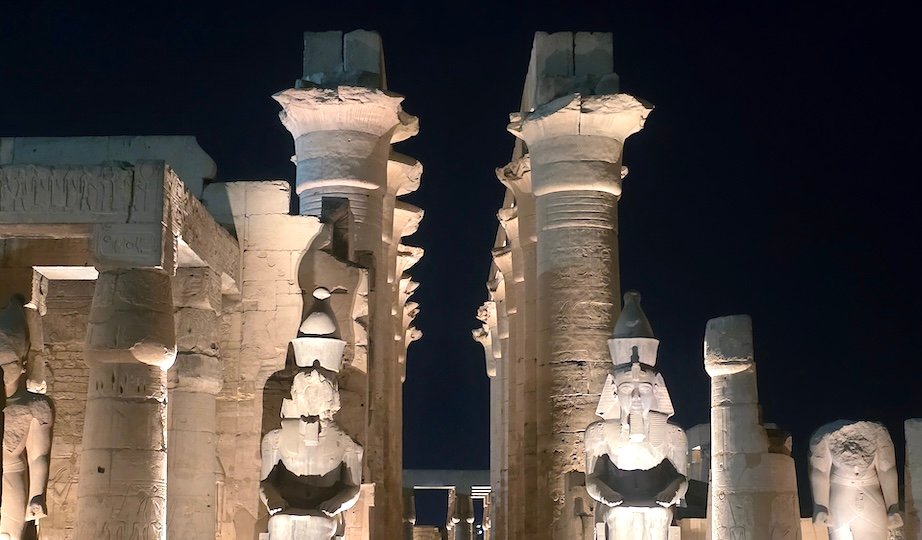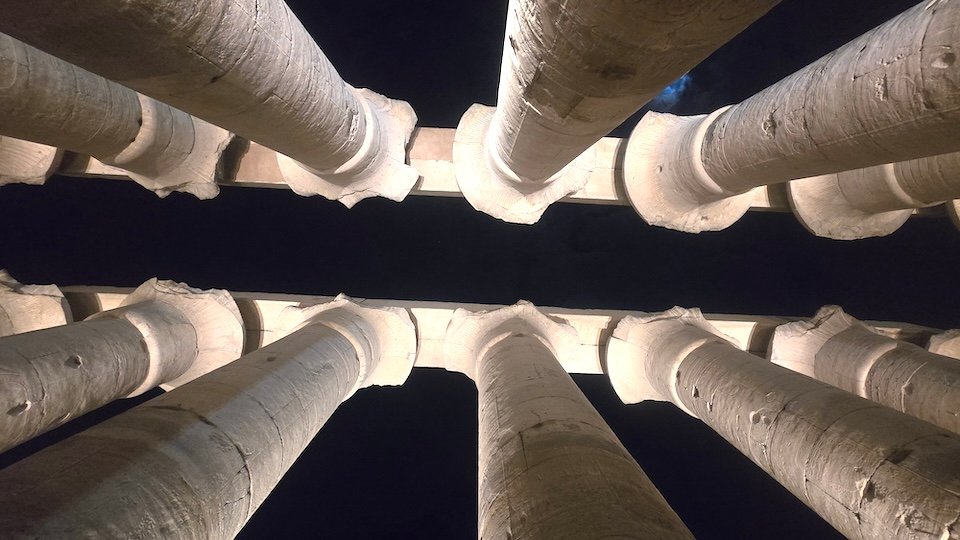Luxor Temple
The first thing that draws the visitor to the modern city is the huge, tall temple overlooking the River Nile, which is called the Luxor Temple.
King “Amenhotep III” (the eighteenth dynasty- father of Akhenaten) chose for this unique location and began building this temple on the ruins of an ancient temple, and he devoted it to the worship of the god Amun in the image of the god “Min,” the god of the fertile, and the old papyrus description says that Amenhotep III built this temple on the land of silver and placed it on a bed of incense.
Then the great warrior king “Tuthmosis III” (18th Dynasty in the Pharaoh kingdom) conducted several expansions and restorations of the old temple, adding some facilities to it, until the temple was completed during the reign of King Ramses II (19th Dynasty), who in turn built the front court of the temple, surrounded with the beautiful, huge columns, and decorated with statues of quartz and granite, and made the entrance in the form of a great edifice consisting of two tall buildings; in front of each of them is a granite statue of the king sitting on his throne.

The entrance to the temple or the edifice of King Ramses II.
The Luxor Temple begins with two great pylons, which were built by King Ramses II, with a height of 25 meters, and it was decorated with views of the war victories of King Ramses II in the Battle of Kadesh against those in Syria.
In front of the temple gate, there are 6 huge statues of King Ramses II: four statues are standing, and two are sitting.
There are also two huge obelisq (one single piece of Granite brought from Aswan to decorate the entrance of the temple), each of which rises to 25 meters, and the temple of them remains only one obelisk, while the other obelisk was transferred by the French in 1833 AD, and the French engineer “Libas” was held in the center of the Concorde Square in Paris in a loud celebration in October 1836 AD.
The Egyptian obelisk remains in the Parisian field today, standing tall with the Hiregolphics (ancient Egyptian language) text inscribed on it: “Ramses, oppressing all foreign peoples, the master of the land who wore the crown, the warrior who defeated millions of opponents and enemies, and who subjected the whole world to his authority and recognized his invincible power.”

Sphinx Road (Celebrations Road).
It is located on the northern side of the temple, and in the past, it spanned three kilometers to reach the temples of Luxor and Karnak, which are statues of the father of the horror, “the king Nekhtnebo I.” He renovated this road and decorated it on both sides with statues of the current Abu Al Houl (The Sphinx).
The road is 200 meters long, and the archaeological evidence tells us how the God Amun ship, which was carrying its sacred statue and coming out of the sanctity of its temple in Karnak, was taken on the shoulders of the priests, heading to the Luxor Temple, penetrating this road among the people until it reached the annual celebration headquarters after the “Obet,” which meant the “beautiful harem.”
The celebration of the Obert feast and the birth of Abu Al-Hajaj takes place.
The Obet Day, or the Obet Festival, is organized to give more sanctity to the Luxor Temple, where the god Amun and his wife, Goddess Mut, and their son, Khonsu, move on three large ships carried on shoulders in what is known as the Holy Triad of Thebes (Luxor).
The scene is repeated in the course of the birth of Sidi Abi Al-Hajjaj Al-Aqsari in the same march and the green ship, and thus, the temple became the Obet Forum, and at the same time, the descendants of Abu Al-Hajjaj inherited the Obet Eid and turned it into the birth of Sidi Abu Al-Hajjaj every year.
Most of the rituals associated with the festival are a blend of Pharaonic and Islamic traditions. According to legend, on this day, Abu al-Hajjaj laughed at the sky and received names from the god; however, these mystical signs are considered unfounded because there is no promotion after the Prophet’s promotion.
The unique view in the city of Luxor is the Sidi Abu Al-Hajjaj Al-Aqsari Mosque. This mosque was erected over a Coptic church that was erected over a Pharaonic temple, in which the three Pharaonic, Christian, and Islamic civilizations gathered in amazing harmony, so the walls of the mosque are the pillars of the Luxor Temple and were discovered when a fire occurred and the Pharaonic inscriptions appeared on the walls.
The mosque was one of the Sufi schools, as it began to restore the Islamic face of Luxor, and people in the past were afraid of residing in Luxor, spreading a rumor that it was saying that it is housing the jinn and spirits and was a city of infidelity.
According to these rumors, the Pharaonic temples are believed to be the dwellings of goblins; therefore, Abu al-Hajjaj decided to build this mosque over a Roman church and invited people to worship there, effectively dispelling the myth of the jinn and Afarat that were thought to inhabit these temples.

The great courtyard of King Ramses II
To the south of the temple gate, the courtyard is surrounded by a double row of columns in the form of bundles of papyrus made of granite with seven statues of King Ramses II, two statues of him while he was sitting, and five while he was standing. Sabotage of these effects occurred from the Persians in the fourth century BC, and in the northeastern part of the courtyard, the Abu Al-Hajjaj Mosque is located.
The birth room is the most important part of the temple.
The Pharaoh Amenhotep III built this temple to devote it to the worship of the god Amun, and this was the religious goal, while the political goal was for the sake of imposing legitimacy to demand the ruling, so he built this temple to confirm his lineage to the god Amun.
The ancient Pharaonic traditions urged that Egypt would take over one of the former sons of Pharaoh or at least marry the daughter of Pharaoh who had previously ruled Egypt, and Amenhotep III did not apply, i.e., the two conditions, so his men and his loyal followers indicated to him the creation of a huge temple to glorify and worship the god Amon Ra and confirm his attribution to him.
Amenhotep III created the birth room like Hatshepsut’s approach in the temple of Al-Deir Al-Bahri, where she depicted her divine birth from the god Amun and her mother, Queen Ahmose; similarly, Amenhotep III decorated the walls of this room with images that illustrate his divine birth.
On the western side of the room, some pictures depict the pregnancy of Amenhotep III’s mother, Queen Mutemwiya, who was a significant figure within the temple and played an important role in its rituals. and non-Egyptian. In these images, the god is represented as the “Mammisi,” which is a significant location within the temple. Amun gives her the “intrigue,” or key to life, symbolizing that he bestowed a soul upon her, and Amenhotep III embodies this spirit.
The birth room, also known as the “Mammisi” in archaeology, is the most significant location within the temple. It represents the symbolic union between the god Amun and Queen “Mutemwiya,” who was the mother of King Amenhotep III.
The Luxor Temple has continuously performed its religious functions, despite the varying rituals of different religions over thousands of years. The worship of the god Amon became central to the community until the Greek era, after which it transformed into a temple and camp during the Roman era, then into a church in the Coptic era, and finally into the mosque of Abi Al-Hajjaj Al-Aqsari in the Islamic era; rituals continue to be held there to this day.
Columns hall
It was constructed by King Amenhotep III and has fourteen columns, seven on each side, that resemble papyrus. The hall is 52 meters long, and one column is 16 meters long. These columns were embellished by Tutankhamun and Seti I, the two monarchs.
At the beginning of the hall, there are two statues of King Ramses II sitting, and to the south lies the “Amenhotep III” courtyard, which is surrounded on three sides by a double row of 46 columns.
It is located south of the Great Pillars Hall, or the Hall of the Recruiture, and it was called “Waskat Ka at” in the ancient Egyptian language. The hall has 32 papyrus-shaped columns, and only the king and priests could enter.
The offer of offerings
It has a four-column roof and is decorated with prominent patterns representing King Amenhotep III, and it offers sacrifices and gifts to the gods.
Roman cabin
At the end of the third century AD, the temple underwent a major change during the era of the Roman Emperor Diocletian, when the temple was surrounded by a huge Roman-style wall built of mud brick and had stone gates for immunization, and the changes extended to the king’s cult room, which turned into a place for the ritual rituals.
The temple continued as a center for Luxor during the Middle Ages, when many churches were built inside and around it, such as the Church of St. Takla in front of the eastern edifice, and the walls of another church can be seen in the first courtyard below the newly restored Abu Al-Hajjaj Mosque.
The temple included three Roman temples and a church, and the Romans were engraved on the walls of the Luxor Temple, along with drawings and views of Alexander the Great.
The Opet Hall, which is part of the Luxor Temple, holds significant sanctity.
The south of the offerings is where the 12 columns are located, leading to the sacred structure of the god Amun, where King Amenhotep III built this temple, which is considered the sanctity of the sanctuary of the temple and the first hall built in it, as it was devoted to the worship of the god Amun and the offering of sacrifices and offerings to him and was also called the altar.
The Obet hall was intended for astronomical purposes, as the 12 columns indicate the number of months of the year, and the sun is perpendicular to each column in a month of months.
All Egyptian scientists think this hall’s purpose is uncertain, as archeology requires proof to confirm something’s health. This hall was completely covered, but no texts or inscriptions prove it was used for astronomy.
Now, after knowing the features of the Luxor Temple, and at the end of your journey around Luxor, and while you’re sailing on the Nile, your visit to Luxor will be one of the most prominent stations of your trip. This amazing ancient temple gives your journey a special charm, especially when lit in the evening.
Wandering in it, seeing huge statues and fine engraving, tells you the stories of ancient Egypt. You will feel as if you have gone back in time.
Upon returning on the Nile Cruise ship, you will feel a strong charm and a strong connection with this ancient past. Luxor Temple is a strong reminder of Egypt’s ancient history, and it will make your Nile journey more charming.
Trusted Partners
Nile Cruisen: Chosen by Leading Brands as Egypt's Top Cruise Operator











